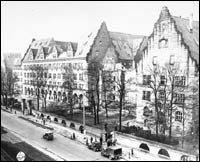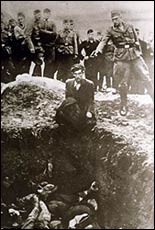Elite Military Killing Squads
Nuremberg, nestled in southern Germany, was painstakingly rebuilt after the Second World War. Most of the city center was flattened by Allied air attacks and most government buildings were destroyed.
AUDIO EXCERPT
Physical destruction in Germany
(Real Audio; 1:30 min)
German historian Jorg Friedrich
|

The Palace of Justice in Nuremberg, where the International Military Tribunal trial of war criminals was held. Photo: National Archives, courtesy of USHMM Photo Archives
|
Most, that is, except Nuremberg's Palace of Justice. It was in the gray sandstone building that the Nazis had enacted notorious Race Laws years earlier. Those laws were later seen as a key step toward the mass murder of Jews and other minorities.
The Allied powers chose Nuremberg as the location of the trials for the city's symbolic importance to the Nazi rise to power, but also because it was one of the only courthouses in Germany that withstood the Allied air war.
Today, outside Nuremberg's Palace of Justice, there's no sign, no plaque, no hint of the historic experiment that took place inside nearly 60 years ago.
Nuremberg prosecutor Benjamin Ferencz recently returned to Courtroom 600 where he prosecuted one of the most shocking cases at Nuremberg. "I was the chief prosecutor against SS extermination troops that murdered over a million people in cold blood," says Ferencz.

German soldiers of the Waffen-SS and the Reich Labor Service look on as a member of an Einsatzgruppe prepares to shoot a Ukrainian Jew kneeling on the edge of a mass grave filled with corpses. Photo: Library of Congress, courtesy of USHMM Photo Archives
|
The units—called the Einsatzgruppen—consisted of some 4,000 men who followed regular Germany army troops into conquered territory, usually in the Soviet Union. There they would round up Jews, gypsies and others, including Soviet Communist party officials. The prisoners would then be executed and their bodies dumped into pits.
These were not top Nazi leaders but elite military squads that conducted widespread killing. When the trial of the Einsatzgruppen opened in 1948, Benjamin Ferencz told the court: "The slaughter committed by these defendants was dictated not by military necessity but by that supreme perversion of thought, the Nazi theory of the master race."
In investigating the Nazi atrocities, researchers had discovered a massive archive in the Nazi foreign ministry in Berlin. The documents were a goldmine for prosecutors like Benjamin Ferencz. Among a wide range of material detailing Nazi extermination efforts were daily reports compiled by Einsatsgruppen commanders. "Every day," says Ferencz "they reported to Berlin which unit had entered which town, under the command of which officer and how many people they murdered in cold blood at that time. By taking an adding machine and adding up the numbers I reached a total of over a million people had been slaughtered that way by these special units."
The records themselves were so damning that Ferencz called no witnesses. In all, 24 of the Einsatzgruppen defendants were found guilty. Thirteen got a death sentence and the others were sentenced to long prison terms.
Next: Sweeping Views of Justice 

